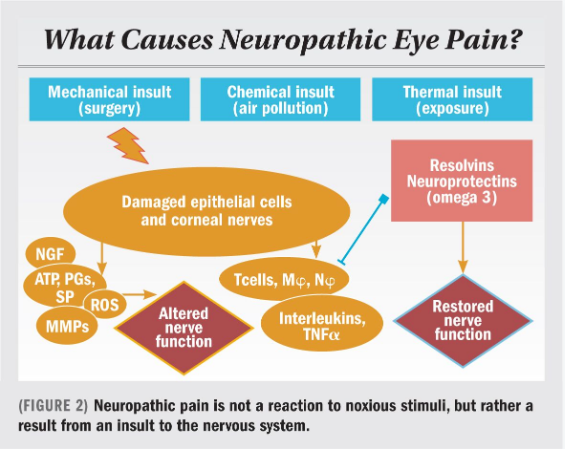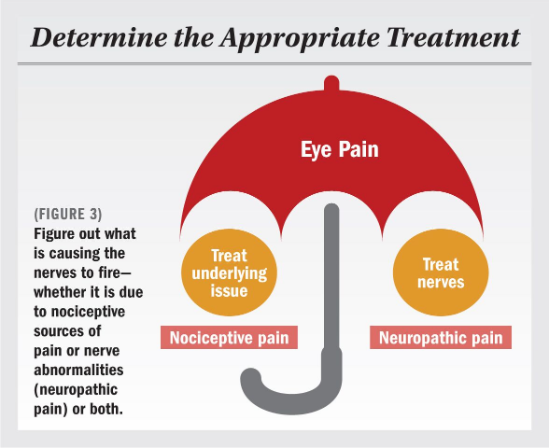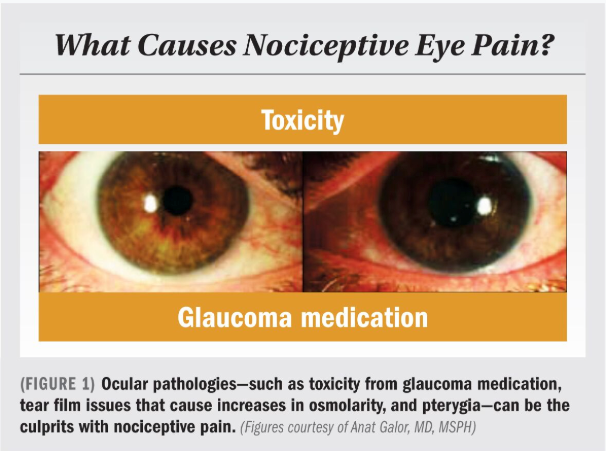Article
Differentiating ocular pain: Nociceptive or neuropathic
Author(s):
Look beyond ocular surface dysfunction for clues, causes of dry eye pain



Dry eye signs and symptoms may point to a culprit outside of the ocular surface.
Reviewed by Anat Galor, MD, MSPH
Corneal neuropathic pain seems to be a “neglected stepchild,” compared with nociceptive pain, in that it is under evaluated by cornea specialists. Though the two disorders are different with different causes, both can occur concomitantly in patients.
Both pain syndromes can result in patients presenting with complaints of dry, burning, and aching eyes, said Anat Galor, MD, MSPH, associate professor of ophthalmology, Bascom Palmer Eye Institute, University of Miami Miller School of Medicine, and staff physician, Miami Veterans Affairs Medical Center.
Ophthalmologists should not limit their investigations to the ocular surface when patients present with dry eye symptoms.
“Focusing on the ocular surface alone is a disservice to the patient,” she said.
Nociceptive pain is triggered by noxious stimuli, which can trigger nociceptors to fire and cause the painful sensation. Ocular pathologies-such as pterygia, conjunctivochalasis, tear film issues that cause increases in osmolarity, environmental factors, and toxicity from glaucoma medication-can be the culprits.
On the other hand, neuropathic pain is not a reaction to noxious stimuli, but rather a result from an insult to the nervous system.
“Mechanical (surgery), chemical (air pollution), and thermal (exposure) insults can damage epithelial cells and corneal nerves, with subsequent upregulation of nerve growth factor and matrix metalloproteinase, among others,” Dr. Galor said. “This can lead to alterations in corneal nerve function.”
The body can repair itself after an acute insult (often with the help of omega-3-derived lipid mediators such as neuroprotectins and resolvins), she noted.
“However, sometimes due to a severe or ongoing insult or genetic predisposition, corneal nerves can become permanently dysfunctional, resulting in neuropathic ocular pain,” Dr. Galor said.
When nerves become dysfunctional, they fire spontaneously or at a lower threshold-causing both spontaneous and evoked eye pain that may be characterized as “dryness” or often described using terms such as “burning,” “aching,” and “tenderness.” Ocular pain in these cases is often provoked by wind and/or light.
Four-step diagnostic approach
The key to making the distinction between the two pain disorders is determining the level at which pain occurs. Here are four steps Dr. Galor uses:
- Conduct a standardized work-up evaluating both symptom severity and chronicity, breaking symptoms into categories of pain (dryness, spontaneous, and evoked pain) and visual complaints.
- Ask the patient about the presence of systemic issues that include systemic autoimmune conditions, depression and anxiety, chronic pain, medication use, and the use of a continuous, positive-airway pressure system for sleep apnea.
- Conducts an ocular surface examination.
- Ask the patient if he or she feels persistent pain after instillation of an anesthetic agent.
Other considerations
Some clues are recognition of the risk factors for neuropathic pain, which include LASIK and the presence of pain elsewhere in the body. Another clue is a disconnect between symptoms and signs of disease, with symptoms outweighing signs, Dr. Galor noted.
For patients in whom dry eye medications are not effective, an under lying nerve issue should also be considered.
“A need in the field is to develop better tests that can quantify corneal nerve function and develop specific therapies for neuropathic ocular pain,” she said.
The take-home points are that eye symptoms characterized as “dryness,” “burning,” and “shooting pain” indicate that nerves are firing, she said.
“The important factor is to figure out what is causing the nerves to fire-whether it is due to nociceptive sources of pain or nerve abnormalities (neuropathic pain) or both,” Dr. Galor said.
Not all symptoms of dryness are driven by “dry eye,” i.e., aqueous tear deficiency, she added.
“The key to achieving happy patients is to determine the cause of pain and to treat it appropriately.” Dr. Galor concluded.
Disclosures:
Anat Galor, MD, MSPH
E: agalor@med.miami.edu
Dr. Galor is a consultant to Allergan, Dompe, Novaliq, and Shire.
Newsletter
Don’t miss out—get Ophthalmology Times updates on the latest clinical advancements and expert interviews, straight to your inbox.





